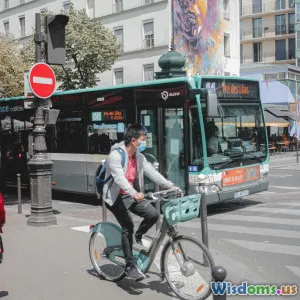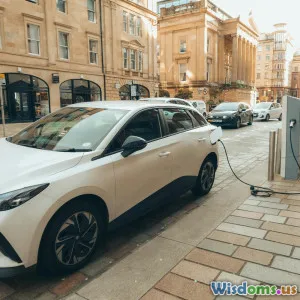
Sustainable Urban Mobility Trends
6 min read Explore cutting-edge sustainable urban mobility trends transforming transportation and cities worldwide. (0 Reviews)
Sustainable Urban Mobility Trends
Urban centers today face multiple challenges in transportation—from traffic congestion and pollution to limited space and changing commuter demands. As cities expand, the traditional model of car dependency proves increasingly unsustainable. However, the dawn of innovative sustainable urban mobility trends is transforming how people and goods move within cities, promising a cleaner, more efficient, and equitable future.
Introduction: Why Sustainable Urban Mobility Matters
The global urban population now exceeds 55% and continues to grow, intensifying pressure on transportation systems. Conventional vehicles fueled by fossil fuels contribute nearly 14% of global greenhouse gas emissions, according to the IPCC. Consequently, sustainable urban mobility has become critical not only for environmental goals but also for improving air quality, reducing noise pollution, and enhancing overall livability.
Sustainable urban mobility integrates environmentally friendly technologies with equitable access and innovative designs to create efficient transport. From electric vehicles to bike-sharing schemes and smart infrastructure, these trends redefine transportation paradigms.
Electrification of Urban Transport
Rise of Electric Vehicles (EVs)
Electric vehicles, particularly electric cars and buses, are exemplars of sustainability. They offer zero tailpipe emissions, reducing urban air pollution and carbon footprints. Cities like Oslo report over 60% of new car sales being electric as of 2023, a global benchmark demonstrating policy efficacy combined with market adoption.
Governments worldwide are enhancing incentives — from tax breaks to expanding charging networks — to accelerate EV adoption. For example, London's Ultra Low Emission Zone (ULEZ) emphasizes electric vehicles for clean air targets.
Electric Buses and Public Transit
In addition to private cars, bus electrification is booming. Shenzhen, China, operates the world’s largest all-electric bus fleet, with approximately 16,000 electric buses replacing diesel counterparts and slashing emissions. Electrified public transport advances both environmental and health outcomes.
Micromobility and Active Transit
E-Scooters, E-Bikes, and Shared Mobility
Emerging micromobility options such as e-scooters and e-bikes are reshaping short-distance urban transit. They're ideal for the “last mile” — connecting public transit with homes or workplaces.
Cities like Paris and Berlin successfully implemented shared e-scooter programs, reducing short car trips and carbon emissions. Recent studies reveal that these scooters replaced approximately 30% of car trips among users, underscoring significant environmental benefits.
Encouraging Active Travel
Encouragement of walking and cycling through improved infrastructure concurrently boosts health and sustainability. The transformation of streetscapes to include wider bike lanes and pedestrian zones helps cities like Copenhagen, a model city for cycling, where over 62% of residents commute by bike daily.
Smart Infrastructure and Data-Driven Mobility
Intelligent Transportation Systems (ITS)
Smart infrastructure integrating sensors, data analytics, and connectivity optimizes traffic flow, reduces congestion, and informs urban planning. For example, Barcelona utilizes ITS to adjust traffic signals dynamically, cutting idling time and emissions.
Mobility-as-a-Service (MaaS)
MaaS platforms aggregate various transport services—buses, trains, bike shares, ride-hailing—into one accessible digital interface. Helsinki leads in MaaS implementation via its Whim app, providing users with tailored, sustainable transit options that reduce the need for private car ownership.
Policy and Urban Design Supporting Sustainable Mobility
Urban policy frameworks are imperative for scaling trends. Congestion charges, low-emission zones, and parking reforms discourage car use while funding public transit and infrastructure upgrades.
Urban design that prioritizes mixed-use development reduces travel distances and encourages sustainable modes. Examples include Singapore’s Transit-Oriented Development (TOD) strategy, which integrates housing, workplaces, and leisure with transit hubs.
Conclusion: Toward a Cleaner, Smarter Urban Mobility Future
Sustainable urban mobility is no longer a distant ideal but an actionable trajectory changing city landscapes worldwide. From electrified transport and micromobility to smart infrastructure, these trends collaboratively reduce emissions, tame congestion, and improve livability.
The synergy of technology, policy, and urban design is paramount. As cities continue to innovate and adapt, residents are presented with cleaner air, healthier lifestyles, and more equitable access to transportation opportunities. Embracing these trends is essential for resilient, vibrant urban futures.
Call to Action
Engage with local and global initiatives promoting sustainable transportation — from advocating for better bike lanes to choosing electric or shared transit options — the future of urban mobility is in our hands.
Sources:
- Intergovernmental Panel on Climate Change (IPCC), 2021
- Oslo EV Sales Data, Norwegian EV Association, 2023
- Shenzhen Electric Bus Deployment, BNEF, 2023
- Paris E-Scooter Usage Study, ITS Journal, 2022
- Copenhagen Cycling Report, City of Copenhagen, 2021
- Barcelona Smart Traffic Systems Case Study, UITP, 2022
- Helsinki MaaS Whim Application, MaaS Alliance, 2023
- Singapore Transit-Oriented Development Policies, URA Singapore, 2023
Rate the Post
User Reviews
Popular Posts





















